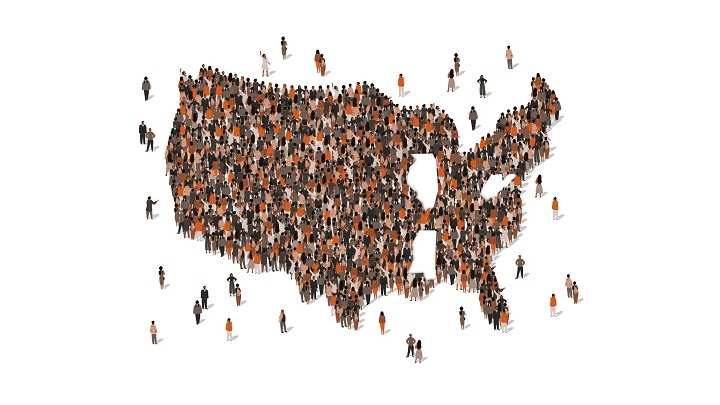United States Census Bureau Releases Data: Significant Increase in Hispanic, Asian Population
United States Census,Overall Positive,U.S. Census Bureau,U.S. House of Representatives,Politics,Population growth,Video Syndication. The government released data from the 2020 census showing large increases in the populations of people who identify as Hispanic, Asian and more than one race. The results from the 2020 census are meant to be a snapshot of the population as of April 1, 2020. The data will show how the population has changed. The census bureau’s data will take weeks to sort out, but commissions and legislatures can now begin to draw maps after months of delays. census.2021

The Census Bureau delivered its most definite look so far enumerating the consequences of the 2020 census on Thursday evening, launching what is generally anticipated to be an exceptionally hostile fight as states start redrawing the limits of legislative areas.
The information incorporates a breakdown of segment classifications like race, Hispanic beginning and age, down to a local square. The bureau likewise posted segment information for each city with more than 5,000 occupants.
The outcomes showed the quantity of White inhabitants in the U.S. declined over the previous decade, falling by 8.6%, while the quantity of racial minorities spiked significantly. The grown-up population likewise became quicker than the country overall, with 258.3 million individuals beyond 18 a 2010 years old, increment since 2010.
Redraw Congressional Maps and Kickstarting Redistricting
The population figures and the square by-block breakdown are required for commissions and state governing bodies to start their once-in 10 years interaction of redistricting: redrawing the limits of everything from legislative and authoritative areas to city wards. In April, the Census Bureau divulged the quantity of legislative seats each state will get dependent on the decennial population tally.
Thursday’s delivery fills in as the beginning gun for the cycle. The actual information was delivered in a confounded, non-easy to understand design, and redistricting bunches expect that commissions and state governing bodies will require a long time to figure out and convert the information before they begin redrawing maps.
A more easy to use variant of this information is scheduled to come out September 30. One merchant depicted Thursday’s information discharge as the “IKEA furniture” rendition: authorities will have every one of the pieces, however should assemble it themselves.
The direness to begin on redistricting originates from delays in census information assortment and each state’s sacred cutoff times for redistricting and up-and-comer recording. A few states, for example, California, Texas and Illinois have pushed or are taking a gander at pushing their cutoff times back. Majority rule and Republican gatherings expect somewhere around 25 to 35 states will be finished with their guides before the current year’s over.
A few states like Colorado and Virginia have begun holding public redistricting hearings or have delivered primer guides to stretch out beyond the interaction and fulfill their time constraints. Thursday’s information will help them make their authority maps.
With Democrats clutching a thin greater part in the House, redistricting will host gigantic repercussions for figuring out which get-together controls the lower chamber after the 2022 midterm races.
Texas, North Carolina and Florida have Republican councils in charge of redistricting, and each state will add no less than one legislative seat. The two Democrats and Republicans accept these councils will attempt to “manipulate,” or define boundaries in their political blessing, enough regions to flip control of the House.
Kelly Ward Burton, chief overseer of the National Democratic Redistricting Committee, composed on Thursday that the gathering trusts Republicans can attract 11 to 16 additional seats their approval in Texas, North Carolina, Florida and Georgia alone.
Liberals are additionally in charge of drawing seats or have last endorsement on maps in verifiably manipulated states like Illinois, Maryland and New York.
Thursday’s information discharge likewise impacts legislative and administrative applicants, who have been in an in-between state in regards to where they are really running because of the postponement in map drawing. In his mission dispatch, Texas Republican competitor Wesley Hunt composed that he will declare the area he’ll run in “when Texas delivers their recently redrawn Congressional region lines.”
As a component of a bigger fight over casting a ballot rights, legislative Democrats have been pushing for entry of the For The People Act, which would command each state set up an autonomous commission for drawing legislative locale lines. The bill has slowed down in the Senate.
The government released data from the 2020 census showing large increases in the populations of people who identify as Hispanic, Asian and more than one race.
The U.S. Census Bureau reported on Thursday that the American population grew much more diverse over the decade with large increases in the populations of people who identify as Hispanic, Asian and more than one race.
The non-Hispanic white population declined by 2.6 percent since 2010, the bureau reported. The African-American population grew 5.6 percent since 2010. The Asian population grew by 35 percent. People who reported being more than one race spiked, an unexpected surge that will draw considerable focus from demographers.
The Census Bureau also reported details on the overall slowing of population growth across the country over the past decade. In all, 52 percent of all counties lost population, according to the new data, the first detailed information on race, ethnicity and population at the local level from the 2020 census.
Population growth was more significant in larger counties; small counties lost population. But there was growth too in some of them.
The top five largest cities in the country are now New York, Los Angeles, Chicago, Houston and Phoenix. Philadelphia is now the sixth largest city, bumped from fifth by Phoenix, which was the fastest growing of the top 20 largest cities. Its population rose by 9.4 percent.
The Villages, a retirement community in Florida is the fastest growing metro area in the country.
McKenzie County, N.D., was the fastest growing county over the past decade, growing by more than 100 percent.
Overall, the nation’s population growth slowed dramatically over the past decade — up by just 7.4 percent compared to the previous decade, the slowest rate in nearly a century.
The new data show which cities and regions are gaining or losing population — and will also offer the most detailed picture of race in America since the last decennial census in 2010.
The numbers will immediately have a practical effect on the political map: They are the basis for redistricting, a process in which state legislatures redraw voting lines based on the changes in their states’ populations.
“These data play an important role in our democracy and also begin to illuminate how the local and demographic makeup of our nation has changed over the last decade,” said Ron Jarmin, acting director, U.S. Census Bureau. He added that the data “meet our high data quality standards.”
He added that the results also help to inform how hundreds of billions of dollars will be spent nationwide.
The nation has been growing more diverse for decades, but recently, the pace has accelerated. Immigration has bolstered the American population, and boosted the economy, bringing a younger work force that is helping support a growing older population. It has set the United States apart from Europe, where there has been less immigration and in some countries, populations have tipped into decline.
Despite the dramatic slowdown in immigration at the end of the last decade in the United States, the proportion of U.S. residents born in foreign countries is still expected to be at its highest point since the last big immigration wave around the turn of the 20th century.
Thursday’s findings are the result of the most embattled census process in decades, conducted during a pandemic under the administration of Donald J. Trump, who tried unsuccessfully to have unauthorized immigrants removed from the count. Some of those immigrants may have been afraid to respond to the census, though states like New York went out their way to count them.
Earlier this year, the government reported that over the past decade the United States population grew at the second slowest rate since it started counting in 1790, a remarkable slackening that was driven by a slowdown in immigration and a declining birthrate.
The bureau in April also reported changes to the nation’s political map: The long-running trend of the South and the West gaining population — and the congressional representation that comes with it — at the expense of the Northeast and the Midwest continued, with Texas gaining two seats and Florida one, and New York and Ohio each losing one. California, long a leader in population growth, lost a seat for the first time in history.
The white, non-Hispanic population, without another race, decreased by 8.6% since 2010, Jones said during a Census bureau press briefing. He cautioned that some of the changes can be attributed to improvements to the survey. The White, non-Hispanic population is still the largest racial group in the U.S.
The release bolstered expert predictions and estimates in past years that showed continued expansion of the Hispanic, Black and Asian American populations and growing numbers of multiracial residents – only a fraction in past surveys.
“The diversity that we’re seeing in this country is going to be much more pronounced,” said William Frey, senior fellow at the Brookings Metropolitan Policy Program.
A small fraction of residents reported being multiracial in 2000 (6.8 million, 2.4%), the first year respondents had the option. That share grew slightly in 2010 to 2.9% or 9 million people, according to the Census Bureau.
The results from the 2020 census, taken amid the pandemic and partisan sniping about the politicization of the process, are meant to be a snapshot of the population as of April 1, 2020. States use the census data to determine legislative and congressional districts – and the Electoral College votes that come with them.
